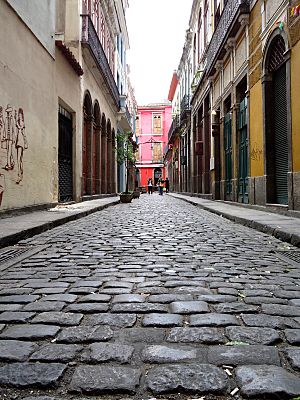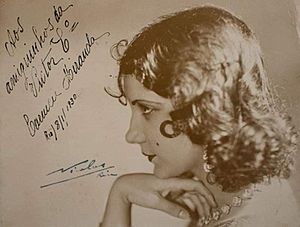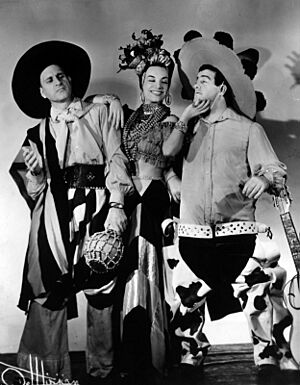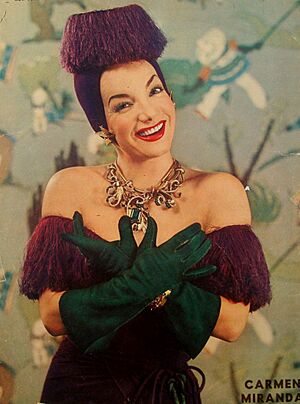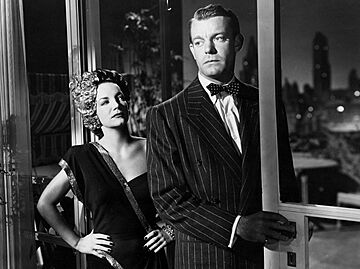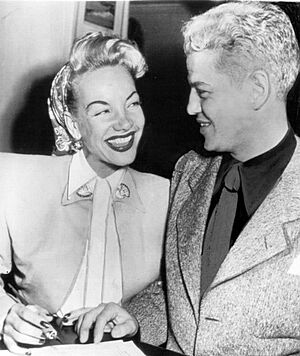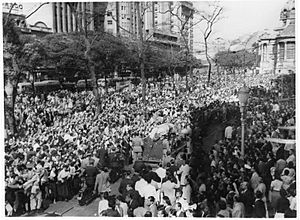Carmen Miranda facts for kids
Quick facts for kids
Carmen Miranda
GCIH OMC
|
|
|---|---|
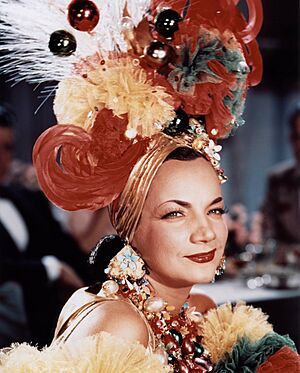
Miranda in a scene from the film Week-End in Havana (1941)
|
|
| Born |
Maria do Carmo Miranda da Cunha
9 February 1909 Marco de Canaveses, Portugal
|
| Died | 5 August 1955 (aged 46) |
| Resting place | São João Batista Cemetery, Rio de Janeiro, Brazil |
| Education | Convent of Saint Therese of Lisieux |
| Occupation |
|
| Years active | 1926–1955 |
| Spouse(s) |
David Alfred Sebastian
(m. 1947) |
| Relatives |
|
| Musical career | |
| Genres | Samba |
| Instruments |
|
| Labels |
|
| Signature | |
 |
|
Maria do Carmo Miranda da Cunha (February 9, 1909 – August 5, 1955), known to the world as Carmen Miranda, was a singer, dancer, and actress who was born in Portugal and grew up in Brazil. She became famous for her exciting performances and colorful outfits, especially her signature fruit hats.
During the 1930s, Miranda performed on the radio and in Brazilian musical movies. In 1939, a producer from Broadway in New York saw her perform and offered her a contract. She soon moved to the United States and starred in her first Hollywood movie, Down Argentine Way, in 1940. Her colorful clothes and Brazilian accent quickly became her trademark.
By 1945, she was the highest-paid woman in the United States. She made 14 movies in Hollywood and became the first Latin American star to have her handprints and footprints in the courtyard of Grauman's Chinese Theatre. Miranda's performances helped make Brazilian music and Latin culture popular around the world. She is remembered as a pioneer of Brazil's Tropicalismo cultural movement.
Early life
Carmen Miranda was born Maria do Carmo Miranda da Cunha in a small town in northern Portugal. She was the second daughter of José Maria Pinto da Cunha and Maria Emília Miranda.
Her father moved to Brazil in 1909 and opened a barber shop in Rio de Janeiro. A year later, her mother followed with their daughters, Olinda and baby Carmen. Even though she lived in Brazil for almost her whole life, Carmen kept her Portuguese citizenship. Her parents had four more children in Brazil: Amaro, Cecilia, Aurora, and Óscar.
Carmen began singing and dancing at a young age. Her father did not approve of her dream to be a performer, but her mother secretly supported her.
At age 14, Carmen started working in a shop to help pay for her older sister's medical bills. She later worked in a boutique where she learned to make hats. She even opened her own successful hat business before becoming a star.
Career
Starting in Brazil
Miranda's singing career began after she met a composer named Josué de Barros. In 1929, she recorded her first song. A year later, her song "Prá Você Gostar de Mim" (also known as "Taí") sold 35,000 copies, which was a record at the time, and made her a star.
She became one of the most popular and highest-paid singers on Brazilian radio in the 1930s. Her fame grew as a style of music called samba became very popular in Brazil. Samba has a lively beat that is perfect for dancing, and Carmen became its most famous performer.
Her movie career in Brazil was linked to musical films called chanchadas. These were fun musical comedies that celebrated Brazilian music and culture, especially the famous Carnival festival. In the 1939 movie Banana da Terra, she first appeared in her famous "Baiana" outfit. This look was inspired by the women of Bahia, a state in northeastern Brazil, and included a colorful dress and a turban decorated with fruit.
Moving to the U.S.
In 1939, an American producer named Lee Shubert saw Miranda perform in Rio de Janeiro. He was so impressed that he offered her a contract to perform on Broadway in New York City. Miranda insisted that her band, Bando da Lua, be hired too, because she felt they were essential to her authentic Brazilian sound. Shubert agreed, and the Brazilian government, seeing a great opportunity to promote their culture, paid for the band's travel.
Miranda arrived in New York in May 1939 and became an instant sensation. Critics and audiences loved her energetic performances. A famous columnist, Walter Winchell, wrote that a new star was born.
Her success on Broadway led to a movie contract with Twentieth Century-Fox in Hollywood. Her first American film was Down Argentine Way (1940). She went on to star in many more musicals, including That Night in Rio (1941), Week-End in Havana (1941), and The Gang's All Here (1943). The musical numbers in this last film featured the giant, amazing fruit hats that became her trademark.
At the time, the U.S. government had a "Good Neighbor policy." This was a plan by President Franklin D. Roosevelt to build stronger friendships with countries in Latin America. Stars like Carmen Miranda were seen as goodwill ambassadors who could help bring the cultures of North and South America closer together.
Challenges and Criticism
While Carmen Miranda was very popular in the United States, she faced some criticism back home in Brazil. When she returned for a visit in 1940, some people felt she had become "too Americanized." Others in Brazil's high society thought her style, which was inspired by Afro-Brazilian culture, was not a good image for the country.
This criticism hurt her deeply. She responded with the song "Disseram que Voltei Americanizada" ("They Say I've Come Back Americanized"). Because of this experience, she did not return to Brazil for 14 years.
Some people in other Latin American countries also felt that her Hollywood movies mixed up different cultures. For example, a movie set in Argentina might feature music and styles from Brazil or Cuba. They felt the movies presented a stereotyped, or overly simple, view of Latin America.
Later Career
After World War II, Hollywood's interest in the types of musicals she made began to fade. Her later films were often in black-and-white instead of bright Technicolor, and her roles became smaller. She wanted to show her acting skills in different kinds of roles, but audiences in America had a hard time accepting her as anything other than the "lady in the tutti-frutti hat."
Although her movie career slowed down, she remained a very popular nightclub performer and appeared on television variety shows. Her final film was Scared Stiff (1953), a comedy with Dean Martin and Jerry Lewis.
Personal life
In 1947, while producing her own movie, Copacabana, Carmen met an American movie producer named David Sebastian. They married on March 17, 1947. Their marriage had its challenges, and they even separated for a short time before getting back together. Miranda, who was Catholic, did not want to get a divorce.
Little is known about Miranda's private life, as she preferred to keep it out of the public eye.
Death
On August 4, 1955, Miranda was filming a segment for the TV series The Jimmy Durante Show. She had been feeling unwell but insisted on finishing the performance. After completing a song-and-dance number, she fell to one knee but quickly recovered.
Later that night, after returning home, she suffered a fatal heart attack in her bedroom. She was only 46 years old.
Her body was flown back to Brazil, where the government declared a period of national mourning. Over half a million Brazilians came to pay their respects at her funeral. She is buried in the São João Batista Cemetery in Rio de Janeiro.
Legacy
Carmen Miranda left a lasting legacy. Her Hollywood image, with platform shoes and towering fruit hats, is recognized all over the world. Her famous hat from The Gang's All Here inspired the logo for Chiquita Banana in 1944.
She is credited with introducing samba music and Brazilian culture to a global audience. The "baiana" style of dress she wore became a popular and iconic look in Brazil, especially during Carnival.
In Rio de Janeiro, the Carmen Miranda Museum opened in 1976, displaying her famous outfits and belongings. For her contributions to the entertainment industry, she has a star on the Hollywood Walk of Fame. In 1998, a public square near Grauman's Chinese Theatre in Hollywood was named Carmen Miranda Square in her honor.
Though she was sometimes criticized during her life, Carmen Miranda is now celebrated as one of the most important and influential Brazilian artists of the 20th century.
Interesting facts about Carmen Miranda
- Carmen Miranda was the first Brazilian artist to achieve worldwide fame in the 1950s.
- As a young woman, Miranda designed hats before she started her singing career.
- Her 1930 song "Taí (Pra Você Gostar de Mim)" made her a huge star in Brazil and the most famous singer of samba music.
- Her father named her Carmen because he loved the opera Carmen.
- Her song "O Que É Que a Baiana Tem?" was added to the National Recording Registry in 2008.
- Curly Howard of the Three Stooges impersonated her in Time Out for Rhythm (1941).
- On September 25, 1998, a square in Hollywood was named Carmen Miranda Square, located near Grauman's Chinese Theatre.
- Her films Down Argentine Way and The Gang's All Here were added to the National Film Registry in 2014.
Filmography
| Year | Title | Role | Notes |
|---|---|---|---|
| 1933 | A Voz do Carnaval | Herself at Rádio Mayrink Veiga | |
| 1935 | Hello, Hello Brazil! | ||
| Estudantes | Mimi | ||
| 1936 | Hello, Hello, Carnival! | ||
| 1939 | Banana da Terra | ||
| 1940 | Laranja da China | ||
| Down Argentine Way | Herself | ||
| 1941 | That Night in Rio | Carmen | |
| Week-End in Havana | Rosita Rivas | ||
| Meet the Stars #5: Hollywood Meets the Navy | Herself | Short subject | |
| 1942 | Springtime in the Rockies | Rosita Murphy | |
| 1943 | The Gang's All Here | Dorita | Alternative title: The Girls He Left Behind |
| 1944 | Greenwich Village | Princess Querida | |
| Something for the Boys | Chiquita Hart | ||
| Four Jills in a Jeep | Herself | ||
| Sing With the Stars | Short film | ||
| 1945 | The All-Star Bond Rally | Herself | |
| Doll Face | Chita Chula | Alternative title: Come Back to Me | |
| 1946 | If I'm Lucky | Michelle O'Toole | |
| 1947 | Copacabana | Carmen Novarro/Mademoiselle Fifi | |
| "Slick Hare" | Herself | Voice | |
| 1948 | A Date with Judy | Rosita Cochellas | |
| 1949 | The Ed Wynn Show | Herself | Episode #1.2 |
| 1949 to 1952 | Texaco Star Theater | 4 episodes | |
| 1950 | Nancy Goes to Rio | Marina Rodrigues | |
| 1951 | Don McNeill's TV Club | Herself | Episode #1.25 |
| What's My Line? | Mystery Guest | 18 November 1951 episode | |
| 1951 to 1952 | The Colgate Comedy Hour | Herself | 3 episodes |
| 1951 to 1953 | All-Star Revue | 2 episodes | |
| 1953 | Scared Stiff | Carmelita Castinha | |
| Toast of the Town | Herself | Episode #7.1 | |
| 1955 | The Jimmy Durante Show | Episode #2.2 | |
| 1995 | Carmen Miranda: Bananas Is My Business | Archive footage |
See also
 In Spanish: Carmen Miranda para niños
In Spanish: Carmen Miranda para niños


